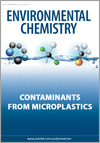EN16198Synchrotron X-ray absorption spectroscopy reveals antimony sequestration by reduced sulfur in a freshwater wetland sediment
Environmental context. Antimony is an environmental contaminant of increasing concern, due to its growing industrial usage in flame retardants, lead alloys, glass, ceramics and plastics. Here we show, using X-ray absorption spectroscopy, that antimony may be trapped in wetland sediments by reduced sulfur. This finding has implications for the management and remediation of wetlands contaminated with antimony.
EN16198 Abstract | EN16198 Full Text | EN16198PDF (452 KB) | EN16198Supplementary Material (207 KB) Open Access Article




